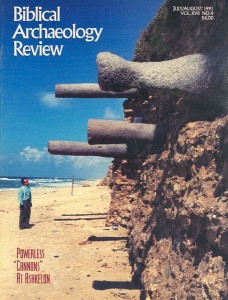This is part III of a three-part article. Part II appeared in the last issue (“Why Were Hundreds of Dogs Buried at Ashkelon?” BAR 17:03).

Throughout most of its 5,000-year history, Ashkelon’s fortunes and destiny were tied to the sea. As a major Mediterranean seaport, it was a commercial and cultural center. From the highlands to the east, a cornucopia of produce and products flowed down to its warehouses before shipment to other ports around the Mediterranean. Olive oil, wine, timber, resin, meat, hides, wool, limestone and chalk, handicrafts and textiles were some of the commodities from the hinterland. The nearby plains and major valleys were breadbaskets for wheat, some of which was also exported through Ashkelon. From the immediate vicinity of the city, fish, wine, garden crops and textiles were, in different periods, part of the local export.
Already a library member? Log in here.
Institution user? Log in with your IP address.

